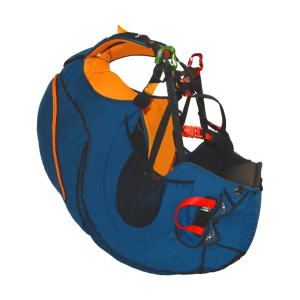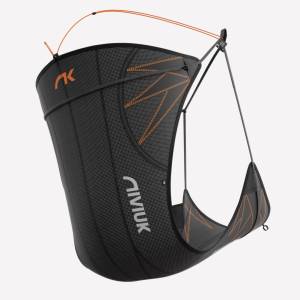Choosing your harness, an important decision!
Choosing your harness is very important in paragliding. It is the link between the glider and yourself, an element of comfort but above all of safety. It is also equipment that you can keep for a long time, much longer than a glider.
The paragliding harness is an important element of piloting where the design and its adjustment will influence the piloting, the behavior of the wing, the sensations of flight, ...
The choice of a particular harness depends on the use you will make of your paraglider, the type of practice you prefer (standard, competition, rando, acro, ...) but also your type of piloting or the level of safety you want.
You will find here different types of harnesses from major brands depending on what you are looking for.
Don't hesitate to contact us if you want more information or advice on the equipment to choose.
How to choose your paragliding harness to start with ?
As for any paragliding equipment, you have different criteria to define on your side to choose your harness:
- Your practice
- Your size
- The desired passive safety
- Your practice: As for the glider, your type of practice will influence the type of harness to choose at your beginning. At the beginning of your practice, you will not have many different practices. It will mainly be a question of knowing if you prefer to progress with simple flights on site and therefore have a beginner's paragliding harness that is more comfortable and safer; or rather rando flights, where lightness and size will be the main criteria of choice. But later, if you want to do cross country, competition, acrobatics, tandem, ... you will have a lot more choice of new or used harnesses.
- Your size: Of course, the size is an important criterion for the choice of a harness (and paragliding equipment in general). Having a paragliding harness that fits your size allows you to be more comfortable in your harness as well as to fly but above all to have maximum safety. A properly sized harness is one that has a backrest height that fits the pilot's back perfectly. The width of the seat should be adapted to the pilot's body size and pelvis width, and the depth of the seat should be adapted to the length of the legs. A gantry test is the best way to check the correct size of the harness. It also allows you to adjust the harness from behind.
- Passive safety: The most important element for a harness to start with is its passive safety, which will help to absorb the low falls that can sometimes happen, especially when landing, and will protect the back and vertebrae. There are two types of back protectors: the foam one which is more solid but protects a little less than the second solution; the airbag which will protect more, is lighter (as it is only an empty bag which will inflate in the air) but which can be damaged more easily.
There are many great brands that offer very good quality paragliding harnesses: Gin, Kortel, Woody Valley, Supair, ... It's up to you to choose the one you need and prefer!
The different types of paragliding harnesses :
- Standard or progression paragliding harness: This is the most common paragliding harness model. It is mainly dedicated to site flying and first distance flights. It emphasizes comfort, safety (active and passive) and stability. The flight position is the sitting position with the possibility to lean back a little.
- Reversible paragliding harness: Often used in touring flight, the reversible harness transforms into a rucksack (hence its name). These models are often heavier than the rando harness but they almost always offer a protection system. It is a system that is increasingly used to save weight and volume in order to be able to go hiking with a bag that is too bulky and heavy, while still offering sufficient protection.
- Light paragliding harness or paragliding harness for hiking and mountain: The paragliding harness for hiking and mountain is used for flights where weight is a constraint. The criteria of comfort, piloting and passive safety are secondary to optimize weight and size. On these models, the seating style is in "waders" mode and the passive protection is reduced to the strict minimum, or even often absent. Some brands offer an optional airbag kit.
- Acro paragliding harness: This model of harness is intended for aerobatics and freeride. It offers a better handling, robustness and safety.
- Cocoon or competition paragliding harness: The cocoon harness is reserved for pilots with a higher technical level. The reclining position with the legs enclosed in a cocoon allows better aerodynamics to improve speed by limiting drag. This type of harness offers physical and thermal comfort for flights that last several hours. This reclining position can also make flight incidents more difficult to control.
- Tandem harness: As the name suggests, these harnesses are designed for tandem flights. They focus on comfort and passive safety. It is also very important to find the right compromise between the weight of the equipment, durability and comfort.
- Children's harness : Children's harnesses are designed for tandem flights with children. There are different criteria to choose from, but the most important is size. The models are designed for different age groups, so your choice will be limited in terms of models.
What is the price of a paragliding harness?
Depending on the different criteria and models, the prices of the harnesses will vary. It is important to know that the harness is a material that you can keep for a long time, if your size does not vary too much and you keep the same practice in paragliding. Prices vary:
- Between 150 and 300€ for a used paragliding harness.
- Between 300 and 500€ for a simple, efficient and often a bit heavy second hand harness.
- Between 500 and 800€ for a good second hand or simple new one.
- More than 800€ for the new paragliding harness of your dreams!
Find in our store all our new or used paragliding harnesses and do not hesitate to contact us if you need advice!










 Marques
Marques







